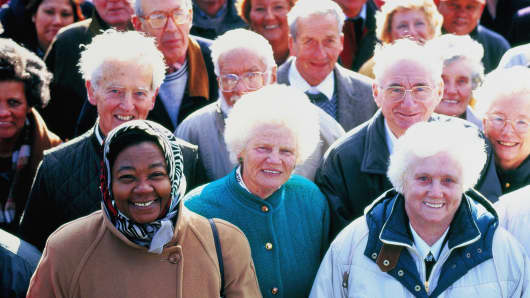Call it the Gray Tsunami. In less than 40 years, the number of people in the world age 80 and older will quadruple. That means a historically unprecedented number of people will need crushingly expensive long-term care, much of it provided by their unprepared children and grandchildren. Yet few countries around the world are paying much attention, at least not yet.
"There will have to be some kind of dramatic shift in the ways things work," said Laurie Orlov, an analyst for the Phillips Center for Health and Well-being Aging Well Think Tank.
Why? Because not only is long-term care expensive, it is also not typically covered by health insurance. In the U.S., about 70 percent of the current population of those 65 and above will at some point need long-term care — defined as assistance over an extended time to manage conditions such as arthritis, a stroke or dementia. Long-term care can include assistance in your home, an assisted living facility or a nursing facility.
And the number of Americans who need that care will soon rise steeply: According to a study by the Deloitte Center for Health Solutions, the projected population in 2050 of individuals age 65 and above is 88.5 million — 20 percent of the total population at that time. That's an increase of 49.6 million from 2008, when the figures were 38.9 million people 65 and over, or 13 percent of the total population.
Even now, 9 million Americans receive long-term care services from family members and friends, at an estimated cost of $199 billion annually.
(Read more: Eight Ways to Invest in Aging Asia)
Most European countries have begun to put in place mechanisms to fund long-term care. But only four countries worldwide — Germany, Japan, the Netherlands, and South Korea — have long-term care insurance systems. Germany's fully covers the cost of care for six months.
Meanwhile, some countries — notably Ireland, Scotland, the U.K., and Japan — are aggressively researching technology-driven solutions.
Orlov said some countries are experimenting with what is called "tele-healthcare" — physicians' visits conducted via Skype or other Web-based technology. They are also using home monitoring technology — for example, a camera installed near a refrigerator to make sure the homeowner is eating. Japan is even experimenting with using robots to pick up and move bed-bound nursing home patients because there aren't enough young workers there to perform nursing and long-term care jobs.
These ideas are now being researched or piloted in the U.S., Orlov said. But she added that there isn't as much attention paid to cutting-edge elderly care ideas in the U.S. because "the problem for us as a society is out in the future." Meanwhile, in countries where governments contribute to the cost of long-term care, there is a clear incentive to accelerate innovation — which is why governments pay for long-term care research.
In many of those countries, the government controls the health care system, functioning in effect as a primary care gatekeeper. But Americans deal with a complicated soup of private health insurance companies (or no health insurance); individual state disability programs; Medicaid; and Medicare, the federal program that guarantees health insurance for Americans ages 65 and older.
(Read more: Caught Off Guard by an Aging Population)
That complicated soup is likely to be with us for a while, said Paul Keckley, executive director at the Deloitte Center. "You can't take anything from another country and cut and paste it into the U.S.," he said.
In the U.S., most long-term care isn't covered by private health insurance or Medicare. If these policies cover nursing home care or home care at all, it is only for a short-term or limited basis. For instance, the maximum length of stay Medicare covers in a skilled nursing facility is 100 days.
Medicare spending is projected to increase from $523 billion in 2010 to $932 billion by 2020, while enrollment is projected to rise from 47 million to 79 million. During the same period, the ratio of workers to enrollees is expected to decrease from 3.7 to 2.4, according to Deloitte.
As a result, it's clear the current system will have to change, according to Keckley.
He predicted Medicare will eventually evolve into a managed care model, with payments made to a team of caregivers with incentives attached to keep patients well.
He also predicted that medical care in general will become more "holistic," incorporating aspects of acupuncture, yoga, and wellness as a way to keep people healthy for longer into their senior years.
(Read more: India's Secret Weapon: Its Young Population)
But he and other experts agree that tweaks to Medicare and behavior modification won't be nearly enough to handle the onslaught of elderly people in need of long-term care.
Jeff Salter, CEO of Caring Senior Service, said one solution might be to allow more immigration. He said he has more clients than caregivers to help them now — and the situation is bound to become more acute in coming years.
But he also said the baby boom generation may have surprises in store, even as it ages. "Our baby boom generation has shaped every step of the way, from social issues to women's rights to ongoing issues today," Salter said. "The unknown is how much they'll stand up and say 'we demand something different.' They can demand robots. They can demand a different kind of housing. As they've done so before, they may rise up again."




